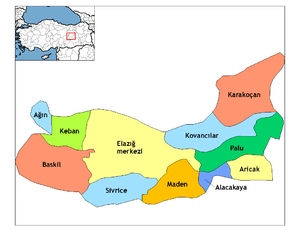Elazığ
Elazığ (Turkish pronunciation: [eˈlazɯː], Zazaki: Xarpêt[3] Kurdish: Elezîz/Xarpêt[4]), formerly Mamuretülaziz, is a city in Eastern Anatolia, Turkey, and the administrative centre of Elazığ Province. It is located in the uppermost Euphrates valley. The plain on which the city extends has an altitude of 1,067 metres (3,501 ft). Elazığ resembles an inland peninsula surrounded by the natural Lake Hazar and reservoirs of Keban Dam, Karakaya Dam, Kıralkızı and Özlüce.[5]
Elazığ | |
|---|---|
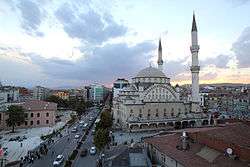 A view of İzzet Pasha Mosque in the city centre. | |
 Seal | |
 Elazığ Location of Elazığ | |
| Coordinates: 38°40′N 39°13′E | |
| Country | |
| Region | Eastern Anatolia |
| Province | Elazığ |
| Government | |
| • Mayor | Şahin Şerifoğulları (AKP) |
| Area | |
| • District | 2,211.07 km2 (853.70 sq mi) |
| Elevation | 1,067 m (3,501 ft) |
| Population (2012)[2] | |
| • Urban | 347,857 |
| • District | 406,300 |
| • District density | 180/km2 (480/sq mi) |
| Time zone | UTC+2 (EET) |
| • Summer (DST) | UTC+3 (EEST) |
| Postal code | 23 xxx |
| Area code(s) | (+90) 424 |
| Licence plate | 23 |
| Website | http://www.elazig.bel.tr/ |
Elazığ was initially developed in 1834 as an extension of the historic city of Harput, which was situated on a hill and difficult to access in winter.
Etymology
The ancient town and citadel of Harput was located about five kilometres (3.1 miles) from modern Elazığ; its name meant "rock fortress" in Armenian, and was pronounced Kharberd, in Eastern Armenian, and Kharpert Խարբերդ in Western Armenian) (Byzantine version, Charpete (Χάρπετε)).
In the 19th century, under the reign of Mahmud II, the governor Reşid Mehmed Pasha started an expansion of Mezre, a suburb located on the plain below Kharput. During the reign of Sultan Abdülazîz, military barracks, a hospital and a governor's mansion were built to accommodate the seat of a new vilâyet (province). The town was renamed "Mamuretülaziz" (Ottoman Turkish: معمورة العزيز made prosperous by Aziz in Ottoman Turkish) in 1866 on the occasion of the fifth anniversary of the enthronement of Sultan Abdülaziz, although he was not the initial founder. In time the city became known as "Elâzîz" due to its ease of pronunciation. On November 17, 1937, President Mustafa Kemal Atatürk changed the name of the city to "El'azık". However, since this was hard to pronounce in Turkish, on December 10, 1937, the government changed the city's name to its final form, "Elazığ".[6]
History
The city of Elazığ was founded among the skirts of the hill on which the historical Harput Castle was constructed. According to the present historical sources, the most ancient inhabitants of Harput was the Hurrian nation who settled in these parts in c. 2000 B.C.
Harput and its surrounding region was part of the kingdom of Urartu at the period of its maximum extension.[7]
The ancient town and citadel called Kharput (Kharpert), which means "rocky fortress" in Armenian, was built by the first Armenian kings about five km (3.1 miles) from modern Elazığ. However, very little written material about this city reached our day. It is possible that Harput stands on or is near the site of Carcathio-certa in Sophene, reached by Corbulo in A.D. 65. The early Muslim geographers knew it as Ḥiṣn Ziyād, but the Armenian name, Khartabirt or Kharbirt, whence Kharput and Harput, was generally adopted in time.
William of Tyre wrote that Joscelin I, Count of Edessa (Jocelyn) of Courtenay, and King Baldwin II of Jerusalem were prisoners of the Amir Balak in Kharput's castle and that they were rescued by their Armenian allies. William of Tyre calls the place Quart Piert or Pierre.
Ottoman Harput and Mamûretü'l-Azîz
Harput and its vicinity fell under Turkish control in the year 1085 as the outcome of the battle of Manzikert on August 26, 1071. The Çubukoğulları, Artuqids, Sultanate of Rum, Ilkhanate, Beylik of Dulkadir, Aq Qoyunlu, Safavids and Ottomans had reigned in the region.[8]
Harput was an important station of the American missionaries for many years. The missionaries built Euphrates College, a theological seminary, and boys' and girls' schools. It operated until 1915 when its buildings were confiscated and used by the Ottoman army as barracks. In November 1895, government-backed Turks and Kurds massacred, looted and burned the Armenian villages on the plain. In the same month, Harput was attacked and the American schools were burned down.[9][10] During the Armenian Genocide, many residents were killed.[11][10]
Harput is still partly settled today, but due to its high elevation and lack of water, it is slowly in the process of being abandoned, with most of its residents moving to Elazığ. Harput still has a few thousand inhabitants.
Turkish Republican era
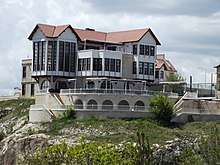
From its foundation until the end of the World War II, the city's growth was somewhat irregular. While the town probably consisted of 10 to 12,000 inhabitants at the beginning of the World War I, the first census conducted by the Republic of Turkey in 1927 counted 20,052 inhabitants. This figure continued to rise to reach 25,465 in 1945, but the general shortages suffered during the World War II years by the neutral Turkey led to an exodus of population, reducing the population to 23,635. From then onward, the city has gone through uninterrupted growth. Harput, in the meantime, acquired the status of a township separated from Elazığ with a population of about 2,000.
Elazıg was the seat of the Fourth Inspectorate-General from 1936[12] until 1952.[13] The Inspectorate General included the provinces of Elaziğ, Erzincan, Bingöl and Tunceli and it was governed by a Governor Commander under the military authority. He had wide-ranging power over the civilians and could order the capital punishment without the permission from the Turkish parliament. The office of the Governor Commander was eventually left vacant in 1948[14] but the legal framework for the Inspectorate-Generals was only abolished in 1952.[13]
Ecclesiastical history
Harput has been the seat of a Syrian Orthodox bishop as early as the eleventh century, whose diocese was initially called Ḥiṣn Ziyād and later Harput. Unlike many Christian dioceses in Turkey, this one is still functioning even after the massacres that took place in the city during the Assyrian and Armenian Massacres, in which the bishop and most of his flock were killed.[15] The diocese has two priests, with the main church being based in the ancient Merymana Kilisesi next to the wall of the old fortress.[16][17]
An Armenian Catholic diocese of Kharput was created in 1850 but was not re-established as a residential diocese after the Armenian genocide, only as an Armenian Catholic Titular see.
An Armenian Evangelical Church, built in the 19th century, survives as a ruined shell of its former self in the middle of a car park.
Economy
.jpg)
In the late 19th and early 20th century, Elazığ exported raisins, apricots and almonds to Europe. Opium was also grown in the area.[18] Honey was also produced, but not so much exported, but used by locals.[19] Gold was also found in the area in the early 20th century.[20]
The most important factor affecting the growth of Elazığ since the 1970s has been the construction of Keban Dam and the hydroelectric power plant (5,871,000 kwh/year) with its boulder at a distance of 45 km (28 mi) from the city and the resulting huge dam reservoir. This reservoir covers an area of 68,000 hectares and it flooded around a hundred villages with a hundred others losing a large part of their agricultural lands. Around 20,000 people were forced to move as a consequence of the dam's construction.
Industries connected with the dam such as a cement mill contributed to the growth, and as Ayalon and Sharon point out, to a striking gap between the male and female populations in Elazığ, the former outnumbering the latter by some eight thousand throughout the seventies, which was a consequence of the move into and settlement in the city of workers employed in the construction effort.
Many of those who were forced to move with the construction of the dam chose to settle in Elazığ centre and the state indemnities paid were invested in houses in Elazığ or laid a base for small businesses. However, the Keban Dam affected more than 30,000 people and at least 212 villages. Over 80% of families in zones affected by the Keban dam were landless peasants and thus ineligible to receive compensation or peasants with little land who would receive very little money (Koyunlu 1982: 250)
The dam, industry, and mining accounts for the high level of urbanization (42.7% in 1970) surpassing the average levels for Eastern Anatolia. The main agricultural activity of the area centers around vineyards and Elazığ also serves as a market hub for other agricultural products. The state-run vineyards of Elazığ are notable for its production of Buzbağ, a full-flavored red wine.
Today, Elazığ is the capital of the Elazığ province, a busy city with a university and an industrial base, although historic monuments are scarce. The exception is the ancient Harput citadel and town, a dependency of the greater municipality of Elazığ today situated three miles (4.8 km) to the north of the city centre. Elazığ is the most developed city (and province) in the region according to a report that was carried out by the Ministry of Development, making it the most developed region of Eastern Anatolia Region.[21]
Geography
Elazığ is situated at the northwestern corner of a 30-mile-long valley, known locally as Uluova (literally the Great Valley). The area's Armenians called this valley "Vosgetashd" (the Golden Plain). Its altitude is 3,300 feet (1,000 m), latitude and longitude of 38 degrees and 41 minutes North, and 39 degrees and 14 minutes East. Elazığ Province is surrounded by the Euphrates in the north, and since the completion of Keban Dam the rivers came to cover almost ten percent of the surface area (826 square kilometres (319 sq mi)) of the province (8,455 square kilometres (3,264 sq mi)). Elazığ's adjacent province borders are with: Tunceli (North), Erzincan (North-West), Bingöl (East), Diyarbakır (South), and Malatya (West).
Climate
Elazığ has a continental climate (Köppen climate classification: Dsa) with cold and snowy winters and hot and dry summers. However, due to the natural and artificial lakes around the city, some partial variations from this climate is experienced.[22]
| Climate data for Elazığ (1960-2012) | |||||||||||||
|---|---|---|---|---|---|---|---|---|---|---|---|---|---|
| Month | Jan | Feb | Mar | Apr | May | Jun | Jul | Aug | Sep | Oct | Nov | Dec | Year |
| Record high °C (°F) | 12.4 (54.3) |
17.3 (63.1) |
26.4 (79.5) |
32.2 (90.0) |
34.4 (93.9) |
38.6 (101.5) |
42.2 (108.0) |
41.4 (106.5) |
37.8 (100.0) |
32.1 (89.8) |
24.3 (75.7) |
19.6 (67.3) |
42.2 (108.0) |
| Average high °C (°F) | 2.9 (37.2) |
4.9 (40.8) |
11.1 (52.0) |
17.7 (63.9) |
23.6 (74.5) |
29.6 (85.3) |
34.3 (93.7) |
34.1 (93.4) |
29.4 (84.9) |
21.7 (71.1) |
12.6 (54.7) |
5.6 (42.1) |
19.0 (66.1) |
| Daily mean °C (°F) | −0.8 (30.6) |
0.5 (32.9) |
5.8 (42.4) |
11.9 (53.4) |
17.2 (63.0) |
22.9 (73.2) |
27.3 (81.1) |
26.8 (80.2) |
21.6 (70.9) |
14.6 (58.3) |
7.1 (44.8) |
1.9 (35.4) |
13.1 (55.5) |
| Average low °C (°F) | −3.9 (25.0) |
−3.1 (26.4) |
1.0 (33.8) |
6.4 (43.5) |
10.7 (51.3) |
15.2 (59.4) |
19.3 (66.7) |
19.0 (66.2) |
14.3 (57.7) |
9.0 (48.2) |
3.0 (37.4) |
−1.1 (30.0) |
7.5 (45.5) |
| Record low °C (°F) | −22.6 (−8.7) |
−21.4 (−6.5) |
−17.0 (1.4) |
−7.0 (19.4) |
0.0 (32.0) |
4.0 (39.2) |
6.7 (44.1) |
10.2 (50.4) |
1.0 (33.8) |
−2.2 (28.0) |
−15.2 (4.6) |
−17.7 (0.1) |
−22.6 (−8.7) |
| Average precipitation mm (inches) | 40.9 (1.61) |
40.9 (1.61) |
53.2 (2.09) |
65.1 (2.56) |
51.5 (2.03) |
12.8 (0.50) |
2.0 (0.08) |
0.7 (0.03) |
7.8 (0.31) |
43.5 (1.71) |
46.9 (1.85) |
43.6 (1.72) |
408.9 (16.1) |
| Average precipitation days | 11.9 | 11.9 | 12.2 | 12.7 | 10.6 | 4.3 | 1.1 | 0.8 | 2.2 | 7.2 | 9.1 | 11.7 | 95.7 |
| Mean monthly sunshine hours | 89.9 | 112 | 173.6 | 207 | 288.3 | 354 | 387.5 | 365.8 | 300 | 223.2 | 144 | 77.5 | 2,722.8 |
| Source: Devlet Meteoroloji İşleri Genel Müdürlüğü | |||||||||||||
Cuisine
Elazığ cuisine is the second richest among all cities in Turkey with 154 different types of food and drinks according to a study conducted by Ankara Chamber of Commerce.[23] Particularly those originated in the historic city of Harput have an important fame in the region and the country. Apart from famous meat platters most of which include meatballs, naturally dried fruits and vegetables and using them in main dishes are unique to Elazığ cuisine. Several examples could include:[5]
- Kofik dolma - stuffed dried peppers or aubergines
- Kelecoş - fried meat and onion served over a bed of flatbread pieces softened in yogurt
- İşkene - a breakfast soup containing broth and vegetables
- Harput köfte - meatballs made with a mixture of minced meat, cracked wheat, herbs and spices boiled in tomato sauce
- Taş Ekmeği - unleavened flatbread baked over hot stone or hotplate served with butter and jam
- Işkın yemeği - a wild rhubarb dish
- Sırın - pan-broiled handmade filo pastry roundels with a layer of yogurt and tomato sauce on top
- Kömme - baked handmade filo pastry roundels built with a layer of meat filling and a layer of walnut paste
- Gaygana - a mixture of eggs, yogurt, bicarbonate, and flour drops fried in oil
- Orcik - walnut halves sewn in a thread, dipped into deep grape syrup
- Orcik şekeri - caramelised sugar coated walnut pieces
Elazığ is also very famous with its vineyards, and two types of grape varieties Öküzgözü and Boğazkere.
Transportation
Elazığ is served by Elazığ Airport which lies about 12 km (7 mi) from the city center. The airport is the 19th busiest airport in Turkey in terms of passenger traffic.[24][25] There are daily domestic flights from/to Ankara, Istanbul and İzmir. During summer months there are some international flights from/to cities such as Düsseldorf and Frankfurt as well as from/to Antalya and Adana.
There are local companies provide coach service to almost all cities in Turkey. Ferryboat services are also present over the reservoir lakes to supplement highway connections to towns such as Ağın, and Pertek and Çemişgezek of Tunceli.
The Blue Train (passenger express) provides connection from Elazığ to Ankara.[5]
Education
Elazığ is home to Fırat University, established in 1975 and since has become one of the leading academic institutions in the eastern Turkey.[26]
Sports
The football team Elazığspor, founded in 1967, represented the city in the Turkish Super League between 2002 and 2004 and again between 2012 and 2014. The club now competes in TFF 1. Lig and their colors are burgundy and white and the club logo is inspired by the local dance Çayda Çıra performed with candles. Elazığ Belediyespor is another professional football team representing the city in the TFF Third League. Elazığ Atatürk Stadium is the home ground to both teams with a capacity of 14,467 seats.
Hazarbaba Ski Center, at the peak of 2,347 metres (7,700 ft) Mount Hazarbaba, is a popular ski destination among the locals.
Elazığ is also home to one of eight major horse racetracks in Turkey. Yurtbaşı Race Course has a capacity of 2,500 spectators and stables have the capacity of stabling around 400 horses.
Attractions
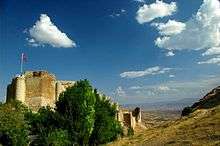
- Fırat University
- Harput Kalesi (Harput Castle)
- Elazığ Culture Park
- Elazığ Botanical Park
- Elazığ Gazi Caddesi
- Buzluk Mağarası (Ice Cave)
- Museum of Archaeology and Ethnography
- Hazar Gölü (Lake Hazar)
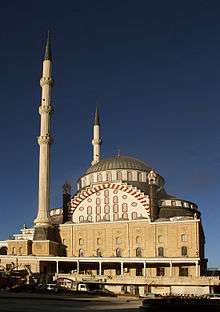
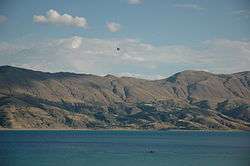
- Hazarbaba Ski Centre
- Historic mosques (Cami in Turkish), churches and shrines (Türbe in Turkish)
- Ulu Camii: Built by Artuqid Sultan Fahrettin Karaaslan in 1156. It is one of the oldest and important structures in Anatolia
- Sarahatun Camii (also known as Sarayhatun Cami): Built by Sara Hatun, mother of Aq Qoyunlu (White Sheep Turkomans) Sultan Bahadır Han (also known as Uzun Hassan), in 1465 as a small mosque. It was renovated in 1585 and 1843.
- Kurşunlu Camii: Built between 1738 and 1739 in Harput during the Ottoman era.
- Alacalı Camii
- Ağall Camii: built in 1559.
- Arap Baba Mescidi ve Türbesi: Built during the reign of Seljuk Sultan Gıyaseddin Keyhüsrev III (son of Kılıçarslan IV) in 1279. The shrine contains a mummified body which is known as Arap Baba among commons.
- Fetih Ahmet Baba Türbesi (Shrine of Fetih Ahmed)
- Mansur Baba Türbesi
- Mary Church
- Sefik Gul Community Center of Culture
International relations
Photo gallery
 Hazarbaba
Hazarbaba Elazığ on a snowy day
Elazığ on a snowy day Elazığ train station
Elazığ train station Elazığ
Elazığ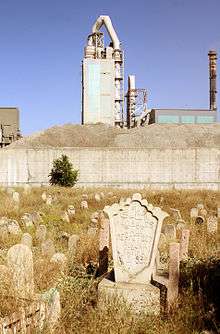 Old cemetery of Elazığ (with a cement plant behind it)
Old cemetery of Elazığ (with a cement plant behind it)
Noatble people from Elazığ
- Feyzi İşbaşaran - (died 1956) Turkish politician and businessman
- Mehmet Ağar — Former leader of the DYP
- Kenan Çoban — Turkish actor, known as abdulhey in Valley of the Wolves
- Vedat Dalokay — Turkish architect and a former mayor of Ankara
- Cahit Kıraç — Former Symrina Governor (now Diyarbakır Governor)"
- Reha Denemeç — Co-founder of the Justice and Development Party (AKP)
- Balak Gazi — Turkish commander
- J. Michael Hagopian - (died 2010) Armenian-American documentary filmmaker
- Hamastegh - (died 1966) Armenian writer, student of Tlgadintzi
- Bekir İrtegün — Turkish professional footballer playing for Fenerbahçe
- Ahmet Kabaklı — (died 2001) Turkish writer
- Esat Kabaklı — Turkish musician
- Dursun Karataş— Founder and leader of the Revolutionary People's Liberation Party–Front (DHKP-C)
- George A. Kiraz—Syriac specialist (grandparents from Ivos, Kharput)
- Fatih Kısaparmak — Turkish musician
- Stephen P. Mugar — (died 1982) Armenian-American businessman and entrepreneur
- Shahan Natalie — (died 1983), Armenian writer and principal organizer of Operation Nemesis
- Catholicos Nerses IV — (died 1173), Armenian church leader, theologian and writer
- Erkan Oğur — Turkish Musician
- Ahmet Tevfik Ozan — Turkish poet/writer
- Necati Şaşmaz — Star of the Valley of the Wolves TV series and the 2006 movie Valley of the Wolves: Iraq
- Raci Şaşmaz — Scriptwriter and producer of the "Valley of the Wolves" and other movies and TV series
- Mümtaz Sevinç — Turkish actor
- Yakup Şevki Subaşı - Military officer in the Ottoman and Turkish armies
- Tlgadintsi (Hovhannes Haroutiunian) — (died 1915) Armenian writer
- Vahan Totovents — (died 1938) Armenian writer, student of Tlgadintzi
- Mahir Ünlü — Turkish Literature writer, from Harput
- Namık Kemal Yolga — Turkish Diplomat and statesman
- Aşur Yusuf — (died 1915) Assyrian journalist and teacher at the Euphrates College
- İhsan Yüce — (died 1991) Turkish actor
- Rupen Zartarian — (died 1915) Armenian writer, student of Tlgad
- Ensar Albayrak - German rapper, stage name Eno
References
- "Area of regions (including lakes), km²". Regional Statistics Database. Turkish Statistical Institute. 2002. Retrieved 2013-03-05.
- "Population of province/district centers and towns/villages by districts - 2012". Address Based Population Registration System (ABPRS) Database. Turkish Statistical Institute. Retrieved 2013-02-27.
- Zazaca -Türkçe Sözlük, R. Hayıg-B. Werner
- Adem Avcıkıran (2009). Kürtçe Anamnez Anamneza bi Kurmancî (PDF) (in Turkish and Kurdish). p. 56. Retrieved 17 December 2019.
- http://www.kultur.gov.tr/genel/medya/iltanitimbrosuru-eng/elazig_eng.pdf
- "ELAZIĞ ismi nerden gelmiştir, adını nasıl almıştır, efsanesi hikayesi nedir - BilgilerSitesi.Com". www.bilgilersitesi.com.
- Anatolian Iron Ages: the proceedings of the second Anatolian Iron Ages Colloquium held at İzmir, 4–8 May 1987.
- "Republic Of Turkey Ministry Of Culture And Tourism". Kultur.gov.tr. Retrieved 2014-08-09.
- "History of Elazig". www.turkeyforyou.com.
- Dadrian, Vahakn N. (2003). The History of the Armenian Genocide. Berghahn Books. p. 160. ISBN 1571816666.
- Henry H. Riggs, "Days of Tragedy in Armenia: Personal Experiences in Harpoot, 1915-1917", 1997, Michigan.
- Soner Çaǧaptay, Islam, Secularism, and Nationalism in Modern Turkey: Who is a Turk?, Taylor & Francis, 2006, ISBN 978-0-415-38458-2, p. 48
- Fleet, Kate; Kunt, I. Metin; Kasaba, Reşat; Faroqhi, Suraiya (2008-04-17). The Cambridge History of Turkey. Cambridge University Press. p. 343. ISBN 978-0-521-62096-3.
- Bayir, Derya (2016-04-22). Minorities and Nationalism in Turkish Law. Routledge. pp. 139–141. ISBN 978-1-317-09579-8.
- Fiey, Pour un Oriens Christianus Novus, 216–17
- "Mor Malki Ürek". soc-wus.org.
- "Google Maps". Google Maps.
- Prothero, W. G. (1920). Armenia and Kurdistan. London: H.M. Stationery Office. p. 62.
- Prothero, W. G. (1920). Armenia and Kurdistan. London: H.M. Stationery Office. p. 64.
- Prothero, W. G. (1920). Armenia and Kurdistan. London: H.M. Stationery Office. p. 74.
- "The most developed and most undeveloped province, 25 May 2012". Haberturk.com. 2012-05-25. Retrieved 2014-08-09.
- "Republic Of Turkey Ministry Of Culture And Tourism". Kultur.gov.tr. Retrieved 2014-08-09.
- "Lezzetli Ülkenin Lezzet Haritası (2008-01-05) - ANKARA TICARET ODASI ". Atonet.org.tr. 2008-01-05. Archived from the original on 2014-09-24. Retrieved 2014-08-09.
- "Statistics". General Directorate of State Airports Authority. Archived from the original on June 28, 2015. Retrieved January 29, 2013.
- "Elazığ - Turkey". World Airport Codes. Retrieved 2019-05-23.
- "History". firatuniversitesi.medyasoftdigital.com. Retrieved 2019-05-23.
- "Twin-cities of Azerbaijan". Azerbaijans.com. Retrieved 2013-08-09.
Sources
- David Ayalon, Moshe Sharon (1986). Studies in Islamic History and Civilization; Article: Ma'mûrat al-Aziz. Brill Publishers. p. 342. ISBN 978-0-510-03200-5.
- Alpaslan Koyunlu (1982). Keban Project 1974-1975 Excavations; Article: The Village Settlement of Mumzuroğlu – Observations on Housing. M.E.T.U.
- Fiey, Jean Maurice (1993). Pour un Oriens Christianus Novus: Répertoire des diocèses syriaques orientaux et occidentaux. Beirut: Orient-Institut.CS1 maint: ref=harv (link)
External links
| Wikimedia Commons has media related to Elâzığ. |
